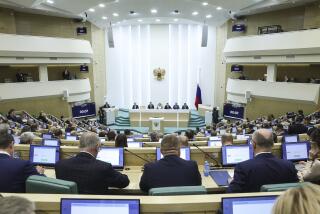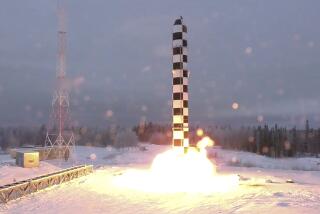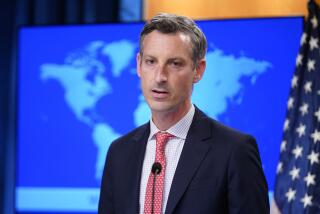U.S. Expected to Agree to Test Ban Talks, Aides Say
WASHINGTON — The Reagan Administration is expected to agree soon to the latest Soviet call for resuming long-halted talks toward a new nuclear test ban agreement, Administration officials disclosed Friday.
But at the same time, they indicated, the United States will significantly lower the goals, and the Soviets, who are asking the United States to join in a nuclear-test moratorium, may find the U.S. position unacceptable.
One senior official, hinting that a total ban would not be sought, predicted, “We won’t go for zero.” Instead, the United States may keep the current 150-kiloton limit on tests and may only seek to place a ceiling on the number of tests with yields at or below that size, two officials said.
In addition, the senior official indicated that the United States may seek to reduce the size of individual underground tests below the 150-kiloton limit, although another official indicated that it is unlikely that President Reagan would accept this idea as he considers various test-ban options.
Nuclear tests in the air and water and in space have been totally banned for more than two decades, and underground explosions with yields greater than 150 kilotons are barred under the Threshold Test Ban agreement negotiated in 1974. That agreement--which has never been ratified, although both the United States and Soviet Union have pledged mutual compliance with it--places no limit on the number of tests.
Supporters of a total ban contend that sophisticated new seismic instruments, coupled with on-site inspections, can detect secret underground tests with yields as low as one kiloton. A kiloton is the equivalent of 1,000 tons of TNT.
Opponents of a test ban, however, say that tests in the 10- to 20-kiloton range--and perhaps as large as 100 kilotons--can be hidden by setting them off in dry, sandy soil that absorbs much of the force of the blast.
In a Dec. 5 letter to President Reagan that was disclosed Thursday, Soviet leader Mikhail S. Gorbachev proposed that the United States join the current unilateral Soviet test moratorium. In exchange, Gorbachev said, the Soviets would permit “on-site observers” at their underground test ranges.
Gorbachev also called for resumption of the trilateral U.S.-Soviet-British negotiations for a comprehensive, total test ban that were halted in 1979. Before those talks ended, the Soviets had accepted the principle of on-site inspection and other verification mechanisms to assure compliance, although U.S. officials said that these were too broadly defined to be acceptable as they were.
Responding to Gorbachev’s letter, White House spokesman Larry Speakes said Thursday that U.S. nuclear tests must continue to “ensure the reliability and safety” of weapons on which American security depends.
Moratorium Accord Doubtful
“We will be glad to continue to talk to them about on-site inspection but, as for a moratorium, we would not agree to it at this time,” he added.
One Administration official suggested Friday that a moratorium might be feasible after the final few underground tests of the warhead for the new Trident 2, or D-5, missile are completed, although others disagreed.
The present Soviet test moratorium, announced last August on the 30th anniversary of the U.S. bombing of Hiroshima, came at the end of an intensive Soviet test series, the Administration has said. It expires Dec. 31, and the Soviet newspaper Pravda, which first reported Gorbachev’s letter, indicated that the Soviet leader’s offer would expire at that time as well.
As a result, Reagan’s response is expected to be sent to Moscow within the next 10 days, another official said.
Despite the White House’s tepid public response, U.S. officials say they have found promise in Gorbachev’s offer of on-site inspection and in the Kremlin’s apparent agreement, conveyed at the same time, to an offer in October by leaders of six nations to install seismic monitoring devices on their territory. The nations that offered to monitor superpower tests are Argentina, Greece, India, Mexico, Sweden and Tanzania.
Enhanced Detection Ability
The instruments, which would supply data to both superpowers, would greatly improve the ability of each side to distinguish between earth tremors and nuclear explosions on the other side’s territory--and thus would enhance their ability to detect any clandestine tests.
Although the Soviets want to resume the three-nation comprehensive test ban talks, there is strong sentiment within the Administration to make those negotiations bilateral, excluding the British. Before the talks ended in 1979, the British had adamantly refused to allow the same number of unmanned seismic stations--10--to be installed on their territory as were planned for the Soviet Union and United States. Without Britain at the table, however, this issue would be moot.
Unless the British and other key North Atlantic Treaty Organization allies strongly object, the Administration is inclined to resume the test ban negotiations, a senior official said. Consultations are under way with London now to determine its reaction.
“Our internal feeling is positive and upbeat” about joining in new test ban talks, this official added, “but you can’t be sure what our response will be until it actually goes out. The allies might talk us out of it for some reason.”
He said the White House favors such talks partly to continue the warming “spirit of Geneva” that occurred following the Reagan-Gorbachev summit last month--and partly to hedge against the Soviets’ blaming U.S. intransigence if they resume underground testing after Jan. 1.
Ban Sincerely Favored
Moreover, one official said, the Administration sincerely favors a comprehensive test ban--one that would extend the present ban on air, space and sea tests to underground tests as well--if adequate verification safeguards can be worked out. Its policy stand has long been that a comprehensive ban was not in current U.S. interests.
But the negotiations on a comprehensive ban, begun in 1977, foundered on greater problems than British refusal to accept the large number of seismic instruments.
According to a study on arms control issues by the National Academy of Sciences, the Jimmy Carter Administration decided against pursuing the comprehensive and controversial test-ban agreement at the same time as it was seeking ratification of the SALT II treaty in 1979. After the Soviet invasion of Afghanistan at the end of that year, the strategic arms agreement was withdrawn from Senate consideration, and the test-ban talks were not resumed.
The on-site inspection provision would have permitted any of the three nations to request an on-site visit to determine whether a suspicious event had been a nuclear test, but the challenged nation could in effect deny the request by explaining why it was unnecessary.
More to Read
Sign up for Essential California
The most important California stories and recommendations in your inbox every morning.
You may occasionally receive promotional content from the Los Angeles Times.










